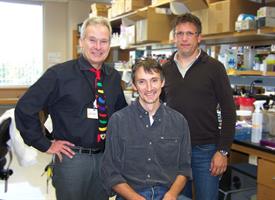 CTSI Incubator Awardee Harris Gelbard, along with Co-Investigators Stephen Dewhurst, Sanjay Maggirwar, and Val Goodfellow, has published a journal article highlighting initial findings. The CTSI Incubator program funded the project entitled “Novel mixed lineage kinase 3 (MLK3) inhibitors: a single target with therapeutic potential in multiple disease states” in 2011. The short term goal of the project is to establish the role and therapeutic potential of MLK3 targeting in HF and pathologic intercellular communication. Long term, the project will reveal a new paradigm for pathologic MLK3 and intercellular communication in multiple disease states and will give rise to numerous further interdisciplinary collaborations. The article is featured in the June 2013 edition of The Journal of Neuroscience and can be accessed here.
CTSI Incubator Awardee Harris Gelbard, along with Co-Investigators Stephen Dewhurst, Sanjay Maggirwar, and Val Goodfellow, has published a journal article highlighting initial findings. The CTSI Incubator program funded the project entitled “Novel mixed lineage kinase 3 (MLK3) inhibitors: a single target with therapeutic potential in multiple disease states” in 2011. The short term goal of the project is to establish the role and therapeutic potential of MLK3 targeting in HF and pathologic intercellular communication. Long term, the project will reveal a new paradigm for pathologic MLK3 and intercellular communication in multiple disease states and will give rise to numerous further interdisciplinary collaborations. The article is featured in the June 2013 edition of The Journal of Neuroscience and can be accessed here.
Abstract:
Human immunodeficiency virus (HIV)-associated neurocognitive disorders (HAND) is a significant source of disability in the HIV-infected population. Even with stringent adherence to anti-retroviral therapy, >50% of patients living with HIV-1 will develop HAND (Heaton et al., 2010). Because suppression of viral replication alone is not enough to stop HAND progression, there is a need for an adjunctive neuroprotective therapy in this population. To this end, we have developed a small-molecule brain-penetrant inhibitor with activity against mixed-lineage kinase 3 (MLK3), named URMC-099. MLK3 activation is associated with many of the pathologic hallmarks of HAND (Bodner et al., 2002, 2004; Sui et al., 2006) and therefore represents a prime target for adjunctive therapy based on small-molecule kinase inhibition. Here we demonstrate the anti-inflammatory and neuroprotective effects of URMC-099 in multiple murine and rodent models of HAND. In vitro, URMC-099 treatment reduced inflammatory cytokine production by HIV-1 Tat-exposed microglia and prevented destruction and phagocytosis of cultured neuronal axons by these cells. In vivo, URMC-099 treatment reduced inflammatory cytokine production, protected neuronal architecture, and altered the morphologic and ultrastructural response of microglia to HIV-1 Tat exposure. In conclusion, these data provide compelling in vitro and in vivo evidence to investigate the utility of URMC-099 in other models of HAND with the goal of advancement to an adjunctive therapeutic agent.
